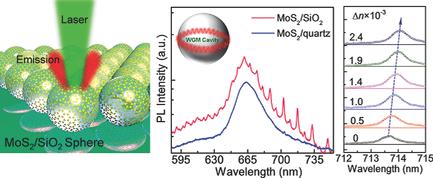Our official English website, www.x-mol.net, welcomes your feedback! (Note: you will need to create a separate account there.)
Tuning Excitonic Properties of Monolayer MoS2 with Microsphere Cavity by High‐Throughput Chemical Vapor Deposition Method
Small ( IF 13.3 ) Pub Date : 2017-09-20 , DOI: 10.1002/smll.201701694 Yang Mi 1 , Zhepeng Zhang 2, 3 , Liyun Zhao 3 , Shuai Zhang 1 , Jie Chen 1 , Qingqing Ji 2, 3 , Jianping Shi 3 , Xiebo Zhou 3 , Rui Wang 1 , Jia Shi 1 , Wenna Du 1 , Zhiyong Wu 1 , Xiaohui Qiu 1 , Qing Zhang 3 , Yanfeng Zhang 2, 3 , Xinfeng Liu 1
Small ( IF 13.3 ) Pub Date : 2017-09-20 , DOI: 10.1002/smll.201701694 Yang Mi 1 , Zhepeng Zhang 2, 3 , Liyun Zhao 3 , Shuai Zhang 1 , Jie Chen 1 , Qingqing Ji 2, 3 , Jianping Shi 3 , Xiebo Zhou 3 , Rui Wang 1 , Jia Shi 1 , Wenna Du 1 , Zhiyong Wu 1 , Xiaohui Qiu 1 , Qing Zhang 3 , Yanfeng Zhang 2, 3 , Xinfeng Liu 1
Affiliation

|
Tuning the optical properties of 2D direct bandgap semiconductors is crucial for applications in photonic light source, optical communication, and sensing. In this work, the excitonic properties of molybdenum disulphide (MoS2) are successfully tuned by directly depositing it onto silica microsphere resonators using chemical vapor deposition method. Multiple whispering gallery mode (WGM) peaks in the emission wavelength range of ≈650–750 nm are observed under continuous wave excitation at room temperature. Time‐resolved photoluminescence (TRPL) and femtosecond transient absorption (TA) spectroscopy are conducted to study light‐matter interaction dynamics of the MoS2 microcavities. TRPL study suggests radiative recombination rate of carrier‐phonon scattering and interband transition processes in MoS2 is enhanced by a factor of ≈1.65 due to Purcell effect in microcavities. TA spectroscopy study shows modulation of the interband transition process mainly occurs at PB‐A band with an estimated F ≈ 1.60. Furthermore, refractive index sensing utilizing WGM peaks of MoS2 is established with sensitivity up to ≈150 nm per refractive index unit. The present work provides a large‐scale and straightforward method for coupling atomically thin 2D gain media with cavities for high‐performance optoelectronic devices and sensors.
中文翻译:

高通量化学气相沉积法调节微球腔单分子层MoS2的激子性质
调整2D直接带隙半导体的光学特性对于光子光源,光通信和传感中的应用至关重要。在这项工作中,通过使用化学气相沉积法将二硫化钼(MoS 2)直接沉积到二氧化硅微球共振器上,成功地调节了其激子性质。在室温下连续波激发下,在≈650–750 nm的发射波长范围内观察到多个回音壁模式(WGM)峰。进行时间分辨光致发光(TRPL)和飞秒瞬态吸收(TA)光谱研究MoS 2的光-质相互作用动力学微腔。TRPL研究表明,由于微腔中的赛尔效应,MoS 2中的载子-声子散射和带间跃迁过程的辐射复合速率提高了约1.65倍。TA光谱研究示出了带间跃迁过程的调制主要发生在PB-A频带与估计˚F ≈1.60。此外,建立了利用MoS 2的WGM峰的折射率感应,灵敏度高达每个折射率单位≈150nm。本工作为将原子薄的2D增益介质与用于高性能光电器件和传感器的腔耦合提供了一种大规模,直接的方法。
更新日期:2017-09-20
中文翻译:

高通量化学气相沉积法调节微球腔单分子层MoS2的激子性质
调整2D直接带隙半导体的光学特性对于光子光源,光通信和传感中的应用至关重要。在这项工作中,通过使用化学气相沉积法将二硫化钼(MoS 2)直接沉积到二氧化硅微球共振器上,成功地调节了其激子性质。在室温下连续波激发下,在≈650–750 nm的发射波长范围内观察到多个回音壁模式(WGM)峰。进行时间分辨光致发光(TRPL)和飞秒瞬态吸收(TA)光谱研究MoS 2的光-质相互作用动力学微腔。TRPL研究表明,由于微腔中的赛尔效应,MoS 2中的载子-声子散射和带间跃迁过程的辐射复合速率提高了约1.65倍。TA光谱研究示出了带间跃迁过程的调制主要发生在PB-A频带与估计˚F ≈1.60。此外,建立了利用MoS 2的WGM峰的折射率感应,灵敏度高达每个折射率单位≈150nm。本工作为将原子薄的2D增益介质与用于高性能光电器件和传感器的腔耦合提供了一种大规模,直接的方法。



























 京公网安备 11010802027423号
京公网安备 11010802027423号